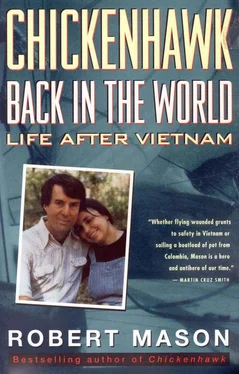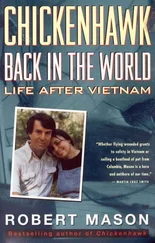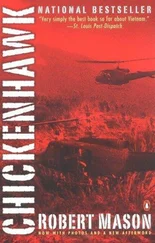Robert Mason - Chickenhawk - Back in the World - Life After Vietnam
Здесь есть возможность читать онлайн «Robert Mason - Chickenhawk - Back in the World - Life After Vietnam» весь текст электронной книги совершенно бесплатно (целиком полную версию без сокращений). В некоторых случаях можно слушать аудио, скачать через торрент в формате fb2 и присутствует краткое содержание. Год выпуска: 2013, Издательство: BookBaby, Жанр: Старинная литература, на английском языке. Описание произведения, (предисловие) а так же отзывы посетителей доступны на портале библиотеки ЛибКат.
- Название:Chickenhawk: Back in the World - Life After Vietnam
- Автор:
- Издательство:BookBaby
- Жанр:
- Год:2013
- ISBN:нет данных
- Рейтинг книги:3 / 5. Голосов: 1
-
Избранное:Добавить в избранное
- Отзывы:
-
Ваша оценка:
- 60
- 1
- 2
- 3
- 4
- 5
Chickenhawk: Back in the World - Life After Vietnam: краткое содержание, описание и аннотация
Предлагаем к чтению аннотацию, описание, краткое содержание или предисловие (зависит от того, что написал сам автор книги «Chickenhawk: Back in the World - Life After Vietnam»). Если вы не нашли необходимую информацию о книге — напишите в комментариях, мы постараемся отыскать её.
Chickenhawk: Back in the World - Life After Vietnam — читать онлайн бесплатно полную книгу (весь текст) целиком
Ниже представлен текст книги, разбитый по страницам. Система сохранения места последней прочитанной страницы, позволяет с удобством читать онлайн бесплатно книгу «Chickenhawk: Back in the World - Life After Vietnam», без необходимости каждый раз заново искать на чём Вы остановились. Поставьте закладку, и сможете в любой момент перейти на страницу, на которой закончили чтение.
Интервал:
Закладка:
“This smuggling business sounds kind of like work, John.”
“That’s a fact, Bob. We’ll earn our money.”
“So, mast, sails, wind vane, and bonding strip. Then we go.”
“Nope. Need to clean out the water tanks—water smells like a damn locker-room shower stall; get a canvas dodger—that’s like a convertible top that sits over the hatchway, keeps major water out when it gets nasty.” John swigged beer. He had a can with him from dawn until he slept. He wiped his mouth with the back of his hand.
“Yep. Need to buy lots of stuff. Tools, spare parts for the engine, nautical charts, food—lots of food. Basically, Bob, what we have here isn’t a yacht; it’s a yacht kit. You like kits?”
We laughed. John was referring to the struggle we had had putting together an ultralight airplane he’d bought six months before. The plane arrived as a big bundle of wires, tubes, and fabric with an instruction book. The thing was complicated, took us weeks to put together. I refused to fly it because it didn’t have what I considered to be proper controls. John flew it, and crashed every time. Disgusted, he later sold it.
“Anyway, most yachts are used like that one.’’ He pointed to the glitzy Hunter. “And they come apart in the first serious storm. I know what boats to use and how to rig ‘em so they make it.”
After John showed me the Namaste , we drove around Jacksonville in his pickup truck buying supplies that John paid for in cash. Getting the boat ready would cost twenty thousand dollars, all cash. He had wads, pounds, stacks of cash. A lot of money flashed around in this business, but I think it was the work itself that John loved the most. “This is free enterprise at its most exciting—one of the last real adventures left, Bob,” he said. “I mean, sailing the seas, avoiding the Coast Guard, pirates, making lots of money. This is exciting stuff. How much adventure is there left in the world? Sometimes I think I lived before and I was a pirate or an explorer, something on the high seas; I can feel it. I did this before.”
“How much time do pot smugglers get these days?” I asked, surprised, but it sprang from my mouth automatically.
John shrugged. “Two years,” he said quietly. “Some people I know did two years.”
A jolt shot through me. Could I handle two years in prison? Did I even want to know if I could? Concern for the consequences is natural before dangerous missions, so I quashed the nagging foreboding that I was on a doomed quest. John knew what he was doing.
I had known what I was doing during the assaults in Vietnam; and I believed that was why I survived. But on this mission I had no training. I didn’t know anything. I’d never been a smuggler before. I didn’t know how to sail, had never even been close to a sailboat. “The odds of being caught,” John continued, “are about nothing outta nothing, Bob. Lotsa guys out there doing this; very few caught. Maybe five percent. If that much.”
We stayed in Jacksonville, living and working on the Namaste during the week, returning to High Springs to visit our wives on weekends. At the marina, John walked to a nearby phone booth at ten o’clock every night and waited five minutes for a phone call from the scam master. The phone rang about every other night. I never heard what was said—didn’t want to.
After the forty-foot mast was stepped, John began to rig the boat. He did most of the rigging himself. He was setting the boat up so most of the lines for the sails—halyards and sheets—were controlled from the cockpit so we wouldn’t have to go out on deck during storms. John gave me a roll of thick copper tape and told me to attach it to the bulkheads in a continuous circle around the inside of the hull. I worked in the cabin most of the time.
Below decks, the Namaste was divided into three compartments. Coming through the hatch from the cockpit, I stepped down a short ladder into the galley, which had a counter we used for navigation plotting and cooking on the starboard side. (The counter was the only table-like surface on the boat. John had removed a fold-out table from the main cabin because it took up too much room. Bales are bulky.) A gimbaled alcohol stove was mounted next to a counter and small sink directly across the aisle. A low partition and a post separated the galley from the main cabin, which had an upper and lower bunk on the port bulkhead, a cushioned bench along the other. The bow compartment contained the head (a pump-to-flush-toilet), a rope locker, two narrow bunks that met at their heads in the triangular bow space, and the sail closet where spare sails, anchors, and spools of line were kept.
John wanted the bonding strip installed neatly because the Namaste would be turned over to a partner after the trip. That partner had put up the money for the boat and the outfitting, and he’d be coming to inspect the boat before we left. I had to thread the copper strip through all the partitions, which meant a lot of tedious cutting and carving to get through the plywood panels and lots of bending and soldering to route the copper ribbon and make it conform to the bulkheads. I spent over a week doing this.
John finished the rigging. The Namaste began to look like a sailboat. She was thirty-six feet from the tip of her bowsprit (a spar that projects from the bow) to the stern, and twelve feet wide. John called the mast and sail arrangement a jib-headed cutter. Two forestays (cables that brace the mast) ran from the mast forward. The longest, from which the jib (forward sail) was set, called the jibstay, ran from the masthead fitting to the tip of the bowsprit. The second stay, which held the staysail (the middle sail), was attached fifteen feet behind and parallel to the jibstay. The mainsail boom, hinged to the base of the mast, hung across the cockpit from the mast to the stem, able to swing inside the running backstay, which was anchored to a small stem pulpit. Shrouds (also cables) ran from the top of the mast to each side of the boat and were held away from the mast with spreaders. All the stays and shrouds were anchored to deck fittings called chinplates, with tumbuckles so you could adjust the tension in the cables. Two plastic-coated cables attached to stanchions, looking like a fence, ran from the bow pulpit (a narrow platform with a steel railing that sat on top of the bowsprit) back along each gunwale to the stem pulpit. This fence-like thing is called a safety line. It is the last thing you can grab when you’re being washed overboard. John added one cable down the middle of the boat, running parallel to the deck, from the mast forward to the bow pulpit. This cable was a safety line to which you could clip the snap-shackle of a safety harness if you had to be out on deck in a storm.
While I finished the bonding strip, John was out buying brand-new radios: a single-side-band long-distance transceiver, a short-range ship-to-ship transceiver, and a loran navigational receiver. When the bonding strip was in place, I ran wires from the aluminum mast and every major cable and metal part of the boat to the bonding strip. If lightning hit anything, the charge would be channeled into the sea.
I unpacked the radios John had stacked in boxes in the main compartment. John had experience installing marine radios, but the details on these high-tech receivers exceeded his knowledge. I knew nothing about installing this stuff, but I studied the instructions in the boxes and visited marine electronics stores and asked them what to do.
When I worked on the boat, it was just work, but interesting work. Something about boats makes mundane chores more fascinating than the same work on land. I didn’t think about what I was doing.
When I was out shopping for wire or paint or caulking or just getting advice, I was constantly aware that I was helping get a sailboat ready for a smuggling trip. I had the childish feeling that everyone I talked to could read my mind—they could see this red neon sign blinking next to me: Smuggler. Blink. Smuggler. It was an eerie feeling, but it was not just paranoia. When people at marinas in Florida see two or three men, who pay for everything in cash, working full-time getting a yacht ready for deep-water sailing, they become suspicious, and it’s usually well founded.
Читать дальшеИнтервал:
Закладка:
Похожие книги на «Chickenhawk: Back in the World - Life After Vietnam»
Представляем Вашему вниманию похожие книги на «Chickenhawk: Back in the World - Life After Vietnam» списком для выбора. Мы отобрали схожую по названию и смыслу литературу в надежде предоставить читателям больше вариантов отыскать новые, интересные, ещё непрочитанные произведения.
Обсуждение, отзывы о книге «Chickenhawk: Back in the World - Life After Vietnam» и просто собственные мнения читателей. Оставьте ваши комментарии, напишите, что Вы думаете о произведении, его смысле или главных героях. Укажите что конкретно понравилось, а что нет, и почему Вы так считаете.












